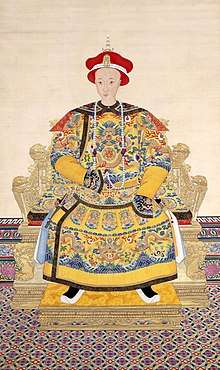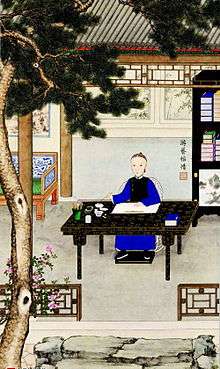Tongzhi Emperor
| Tongzhi Emperor | |||||||||||||||||
|---|---|---|---|---|---|---|---|---|---|---|---|---|---|---|---|---|---|
 | |||||||||||||||||
| 9th Emperor of the Qing Dynasty | |||||||||||||||||
| Reign | 11 November 1861 – 12 January 1875 | ||||||||||||||||
| Predecessor | Xianfeng Emperor | ||||||||||||||||
| Successor | Guangxu Emperor | ||||||||||||||||
| Regents |
Zaiyuan (1861) Duanhua (1861) Sushun (1861) Empress Dowager Ci'an (1861–1875) Empress Dowager Cixi (1861–1875) | ||||||||||||||||
| Born |
Aisin Gioro Zaichun (愛新覺羅 載淳) 27 April 1856 (咸豐六年 三月 二十三日) Chuxiu Palace, Forbidden City | ||||||||||||||||
| Died |
12 January 1875 (aged 18) (同治十三年 十二月 五日) Hall of Mental Cultivation | ||||||||||||||||
| Burial | Hui Mausoleum, Eastern Qing tombs | ||||||||||||||||
| Consorts |
| ||||||||||||||||
| |||||||||||||||||
| House | Aisin Gioro | ||||||||||||||||
| Father | Yizhu | ||||||||||||||||
| Mother | Lady Yehe Nara | ||||||||||||||||
| Tongzhi Emperor | |||||||||||
| Traditional Chinese | 同治帝 | ||||||||||
|---|---|---|---|---|---|---|---|---|---|---|---|
| Simplified Chinese | 同治帝 | ||||||||||
| |||||||||||
The Tongzhi Emperor (27 April 1856 – 12 January 1875), born Zaichun of the Aisin Gioro clan,[1] was the tenth emperor of the Manchu-led Qing dynasty, and the eighth Qing emperor to rule over China proper. His reign, from 1861 to 1875, which effectively lasted through his adolescence, was largely overshadowed by the rule of his mother, Empress Dowager Cixi. Although he had little influence over state affairs, the events of his reign gave rise to what historians call the "Tongzhi Restoration", an unsuccessful attempt to stabilise and modernise China.
Life
The only surviving son of the Xianfeng Emperor and Empress Dowager Cixi, the Tongzhi Emperor attempted political reform in the period of the Tongzhi Restoration. His first regnal name was Qixiang (祺祥; Manchu: Fengšengge sabingga), but this name was later abandoned by Cixi in favour of "Tongzhi", a contraction of the classical phrase tong gui yu zhi (同归与治; 同歸與治), which means "restoring order together". An alternate interpretation reads it as "mother and son co-emperors" (母子同治天下), which fits the state of affairs, as the empress dowager wielded real power and ruled behind the scenes. The traditional Chinese political phrase "attending audiences behind a curtain" (垂帘听政; 垂簾聽政; chuí lián tīng zhèng) was coined to describe Cixi's rule through her son.
The Tongzhi Emperor became emperor at the age of five upon the death of his father, the Xianfeng Emperor. His father's choice of regent, Sushun, was removed in favour of a partnership between his mother Empress Dowager Cixi, Empress Dowager Ci'an, and his sixth uncle Prince Gong.
While there had most likely been hopes that the Tongzhi Emperor would become a leader like the Kangxi Emperor (who ascended the throne as a child in 1661), those hopes would soon come to naught, as the Tongzhi Emperor grew up to become an obstinate and dissolute young man.
In the fall of 1872, the teenage emperor married Empress Xiaozheyi and several concubines. The Tongzhi Emperor apparently had wanted to take up power immediately, prompting a quarrel at court regarding the dismantling of the regency and the timing of it. However, the two empresses dowager stuck by the intended date of February 23, 1873.[2]
The day after the Tongzhi Emperor took up the reins of power, the foreign powers requested an audience with the teenage emperor. The request precipitated a sharp disagreement between the ministers at the foreign legations, who made it clear that they would not perform the ritual kowtow to the emperor, and the Zongli Yamen (foreign affairs ministry), regarding the protocol to be observed. The Qing government was also loath to hold the audience within the confines of the Forbidden City, eventually settling on the "Pavilion of Purple Light" at one of the lakeside palaces to the west of the Forbidden City, which is now part of Zhongnanhai.[3] The audience was finally held on 29 June 1873. After the audience, however, the foreign representatives made clear their annoyance at being received in a hall initially used by the Qing emperors to receive envoys of tributary states.
In the fall of 1874, the Tongzhi Emperor got into a clash with his ministers, which included his two uncles, Prince Gong and Prince Chun, largely over the emperor's plans to rebuild the Old Summer Palace at a time in which the empire was bankrupt, and over his dissolute behavior. The emperor reacted by firing the ministers, but Empresses Dowager Ci'an and Cixi intervened, and he had them reinstated. That December, it was announced that he was ill with smallpox, and the empresses dowager resumed the regency. He died on 12 January 1875, leaving no sons to succeed him.
The Tongzhi Emperor's death left the court in a succession crisis, as, although he was childless, his empress was reportedly pregnant. Eventually, the empresses dowager designated the Tongzhi Emperor's three-year-old cousin, Zaitian, as the heir to the throne. Zaitian was biologically Prince Chun's son, but was symbolically adopted as the Xianfeng Emperor's son to make him eligible to succeed the Tongzhi Emperor. Zaitian was thus enthroned as the Guangxu Emperor, with Empresses Dowager Ci'an and Cixi resuming their roles as regents. The Tongzhi Emperor's empress died a few months later.
Taiping Rebellion
Hong Xiuquan (1814-1864) was peculiarly affected by the social instability of the Canton region. He belonged to a family of modesty well-off peasants from Hua county north of Canton, members of the Hakka community ubiquitous in the region. Hong combined both the Confucian idea and Western Christianity idea to start his Taiping Rebellion. In late 1851, Taiping army occupied its first walled city Yongan.

When 5-year-old Tongzhi Emperor ascend the throne in 1861, the Taiping rebellion was threatening Shanghai. This move prompted several foreign missions of British, French, and Americans to the Heavenly Capital, to warn the Taiping against interference with Western commerce. Foreign neutrality was beginning to fray as Western intelligence of the Taiping revealed both its unorthodox religious ideology and its lack of understanding of the Western world. In order to save Shanghai, Tongzhi Emperor ordered Zeng Guofan to counter-attack the rebel. Zeng's appointment was the turning point in the Taiping war. Zeng was a virtual generalissimo directing a supra-provincial campaign by armies raised and led by his various lieutenants and proteges, supported by the extrodinary mobilization of revenues including the likin tax and customs revenues. His strategy was to move from the west down the Yangzi taking successive cities, while Li Hongzhang, his principal lieutenant, advanced from the east through Jiangsu toward Nanjing.
The Heavenly Capital fell in July 1864. Hong Xiuquan was already dead, on June 1, 1864. The fall of the city was followed by a great massacre. Remnant Taiping forces fled south, including Hong's son the Junior King and Hong Rengan, to continue the movement, but both were soon captured and executed. The last Taiping forces were destroyed in Guangdong in early 1866, having come geographically almost full circle in the course of fifteen years.[4]
The Self-Strengthening Movement

The inspiration for the Self-Strengthening Movement from the 1840s arose from this notion that China's defense in the face of war and rebellion must come from within, as the superior man strengthens himself under imperative of Heaven's robust action. the costs of war and rebellion dictated that Qing dynasty undertake vigorous measures to ensure its survival. Moreover, the very survival of China itself was now at stake. But the problem was that neither the authority of the Yi Jing nor the teachings of history sanctioned the sort of radical change that now was called for.
Self-strengthening efforts evolved in a succession of stages over a period of almost half a century. In 1840 Imperial Commissioner Lin Zexu, impressed by the power of British warships in the initial battles of the Opium War, advocated adoption of Western naval technology. The paddle-wheel steamer Nemsis had run circles around cumbersome Chinese war junks. Some Chinese at first believed the paddle-wheels were powered by men inside the ship, but soon came to appreciate the power of steam, Commissioner Lin was the first self-strengthener. But the appreciation of Western military technology was limited to a very few officials on the scene who were isolated in the vast conservative bureaucracy. Lin's proposals fell on deaf ears. The Court simply did not believe that an emergency existed that could not be handled in the traditional way of reemphasizing the moral values of humanity (ren) and righteousness (yi).
Self-strengthening enterprises, including arsenals, shipyards, and technical schools, were now established in the principal treaty ports where access to Western technology was most direct. Funds to support these projects were diverted from likin tax on goods in transit and from customs revenue. Even the imperialist powers, fearful that their hard-won commercial privileges would be jeopardized if the dynasty collapsed, offered their support. Still, few scholar-officials were persuaded of the necessity of the adoption of Western technology; commitment to traditional learning as a priority remained as strong as ever.
Family
- Parents:
- Yizhu (文宗 奕詝; 17 July 1831 – 22 August 1861)
- Empress dowager Yehe-Nara (孝欽顯皇后 葉赫那拉杏貞; 29 November 1835 – 15 November 1908), personal name Xingzhen
- Consorts:
- Empress Arute (孝哲毅皇后 阿魯特氏; 25 July 1854 – 27 March 1875), eighth cousin once removed
- Second rank consort Fuca (淑慎皇貴妃 富察氏; 24 December 1859 – 13 April 1904)
- Second rank consort Arute (恭肅皇貴妃 阿魯特氏; 20 September 1857 – 14 April 1921)
- Second rank consort Hešeri (獻哲皇貴妃 赫舍里氏; 2 July 1856 – 5 February 1932)
- Second rank consort Silin-Gioro (敦惠皇貴妃 西林覺羅氏; 6 September 1856 – 18 May 1933)
See also
References
- ↑ http://www.dartmouth.edu/~qing/WEB/TSAI-CH'UN.html
- ↑ Seagrave, Sterling Dragon Lady: the Life and Legend of the Last Empress of China (Knopf, 1992), pg. 130-131
- ↑ Seagrave, pg. 131
- ↑ Jonathan,, Porter,. Imperial China, 1350-1900. Lanham. ISBN 9781442222915. OCLC 920818520.
- The draft history of the Qing dynasty 《清史稿》卷二百十四.列傳一.后妃傳.
- Sterling Seagrave, Dragon Lady ISBN 0-679-73369-8.
- Daily life in the Forbidden City, Wan Yi, Wang Shuqing, Lu Yanzhen. ISBN 0-670-81164-5.
- Forbidden City: The Great Within, Second Edition. May Holdsworth, Caroline Courtauld. ISBN 962-217-792-1.
Further reading
| Wikimedia Commons has media related to Tongzhi Emperor. |
- Jung Chang, Empress Dowager Cixi: The Concubine Who Launched Modern China, (2013) ISBN 978-0-307-27160-0.
- Mary Clabaugh Wright. The Last Stand of Chinese Conservatism: The T'ung-Chih Restoration, 1862-1874. (Stanford: Stanford University Press, 1957).
Tongzhi Emperor Born: 27 April 1856 Died: 12 January 1875 | ||
| Regnal titles | ||
|---|---|---|
| Preceded by The Xianfeng Emperor |
Emperor of China 1861–1875 |
Succeeded by The Guangxu Emperor |